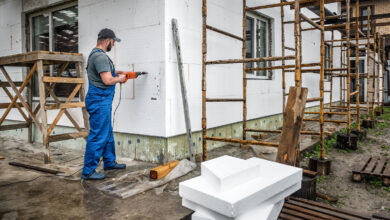Overcoming disruption in residential retrofits

John Curtis, research professor at the Economic and Social Research Institute (ESRI), highlights a crucial but often underestimated factor in homeowners’ decisions about energy retrofits: disruption.
Curtis outlined how the perceived “hassle” of retrofitting – ranging from noise and dust to logistical headaches – can be a major deterrent, even when financial incentives are available.
For policymakers and industry leaders striving to accelerate home energy upgrades, Curtis’ research provides a stark reality check.
“Only about half of homeowners are even realistically considering a retrofit at any given time,” he explains, emphasising that blanket incentive schemes may not be enough to drive widespread adoption. Instead, he asserts, the key lies in both understanding and addressing the disruptions that cause many homeowners to hesitate.
“Addressing disruption directly – rather than assuming homeowners will tolerate it – may be key to increasing retrofit adoption.”
John Curtis, research professor, Economic and Social Research Institute (ESRI)
The toll of disruption
Home energy retrofits are essential for reducing emissions and improving efficiency, yet uptake remains slower than expected. While much of the focus has been on reducing costs and increasing energy efficiency, Curtis’ research suggests that practical concerns often outweigh financial considerations.
“The perception of disruption varies widely among homeowners,” he notes. His research shows that while some homeowners are willing to endure short-term inconvenience for long-term benefits, others, particularly older homeowners or those with young families, see retrofits as “too much hassle, regardless of the potential benefits”.
He adds: “Even if homeowners acknowledge the benefits of a retrofit, the effort required to plan, manage, and live through the process often leads them to delay or abandon the idea.”
Heating system complexity
Another key challenge Curtis identifies is the complexity of existing heating systems. Since many homes, particularly older properties, have a mix of heating technologies such as radiators, underfloor heating, and solid fuel stoves, this makes it difficult for homeowners to choose the best retrofit solution.
“Most households do not have a single heating system,” he explains. “Instead, they have a combination of different systems, which makes the decision-making process far more complicated.” This complexity, he says, can lead to “decision fatigue”, with homeowners ultimately choosing to do nothing rather than risk making the wrong choice.
There is also the fear that retrofitting could disrupt existing systems without delivering substantial improvements. “For those who already have a working heating setup, the idea of tearing it out and replacing it with something unfamiliar can be daunting,” Curtis states, highlighting the need for clearer guidance and support to help homeowners navigate their options with confidence.
Addressing the disruption challenge
Given these insights, Curtis outlined several ways to address the disruption barrier and encourage more homeowners to proceed with retrofits:
- Targeting the right homeowners: Since only around 50 per cent of homeowners are genuinely considering retrofits, Curtis advises that policies should be more targeted. “It is not about convincing everyone, it is about making retrofits easier for those who are already inclined to act,” he says. By identifying and engaging these homeowners more effectively, he asserts that resources can be directed where they will have the greatest impact.
- Reducing perceived and actual disruption: To make retrofits more attractive, efforts must be made to minimise disruption. This could include offering temporary accommodation for major projects, phased installations, or improved project management services. “Homeowners need to feel that they can maintain normal life during a retrofit; otherwise, many will opt out,” Curtis says.
- Providing clearer information and guidance: One of the most significant barriers is uncertainty about what to expect. Curtis stresses the need for more transparent, personalised advice on timelines, costs, and potential disruptions. “Clearer, more practical information could help homeowners make informed decisions rather than feeling overwhelmed,” he says. Case studies and testimonials from homeowners who have successfully undergone retrofits, he states, could also help build trust in the process.
By refining policy approaches, reducing perceived barriers, and improving communication, the ESRI research professor is confident that government and industry stakeholders can help make home energy upgrades a more viable and attractive option.
“If retrofitting programmes fail to account for the real-world challenges facing homeowners, they risk leaving behind a significant portion of households who might otherwise be willing to improve their home’s energy efficiency.
“Disruption is a major, yet often underestimated, factor influencing homeowners’ decisions about energy retrofits,” Curtis says, adding: “While financial incentives and energy savings are important, they are not always enough to overcome concerns about inconvenience and complexity.
“Addressing disruption directly – rather than assuming homeowners will tolerate it – may be key to increasing retrofit adoption,” Curtis concludes.





